Like animals, human beings capture the stimuli that come from our environment through the sense organs. The nervous system is responsible for relating the body with what happens outside. Our body contains receptor organs that deal with relating it to the external environment. These receptor organs offer the necessary information for our adaptation and survival.
![Five Sense Organs [Parts and Functions for Kids]](https://howforkids.com/wp-content/uploads/2022/08/5-Sense-organs-for-lids-300x300.jpg)
The Five Senses and their Functions
Table of Contents
The eyes, nose, tongue, ear and skin are the organs that collect information about our environment and help protect the body because they “warn” what is happening around. The senses allow us to receive external stimuli and react to them by giving the appropriate response in each situation.
- Sight
- Hearing
- Smell
- Taste
- Touch
What are Internal and External Stimuli?
Stimuli are signals that indicate changes in the environment that surrounds us, causing reactions in the body. They can be:
• Internal stimuli: these are signals that come from inside the body such as hunger, thirst, the position of the muscles, among others.
• External stimuli: are those that indicate that external conditions have changed (cold, pain, colour).
How do the Five Senses Work?
The sense organs are made up of specialized cells that connect to the nervous system. It receives the stimuli, processes the information and sends the appropriate response. Examples of stimuli captured by the sense organs are: sounds, colours, flavors, aromas, textures, temperatures of different objects. For example: If we touch a hot object, the skin quickly sends the information to the brain that generates the order to the muscles to remove the hand.
Sense Organs Functions: Summary
The sense organs collect information about our environment that are interpreted by the brain. The nervous system analyzes this information to give the answers.
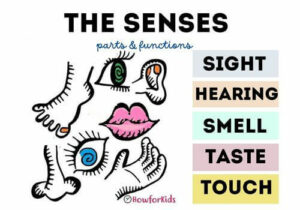
Eyesight
In our eyes we have receptors that detect light. Vision is the ability to detect light and interpret it. They give us information about: the shape of things, the colors they have, if they move, how far we are from them, among others. The receptor organ is the eye or eyeball, which is a paired organ housed in the orbital cavities.
Anatomy and Function of the Eye

Perceive and capture images from the outside and send them to the brain.
The eye has an optical system that focuses the image, receives it in a sensitive layer, processes and emits said image.
The eye captures the images and converts them into nerve impulses that it sends to the brain so that what you are seeing is interpreted. This information travels down the optic nerve.
The Parts of the Human Eye
Our eyes have various structures that, although they do not form the eyeball, contribute to its protection.
• Eyebrows: They are a set of hairs that are above the eyes. Its function is to prevent drops of sweat and water from entering the eye.
• Eyelids: it is the skin that, through muscles, makes the eyes open and close. They protect them from the sun, intense light, dust or air. They keep the eye moist.
• Eyelashes: They are the hairs that are at the ends of the eyelids. Its function is to prevent any foreign element or dust from entering the eyes.
• Lacrimal glands, are internal, but help protect the eye. They are responsible for the secretion of tears (salty and transparent liquid), which allows the eye to always be moist. It also intervenes to protect it from various aggressions such as bacteria, dust, pollens, grains of sand, etc.
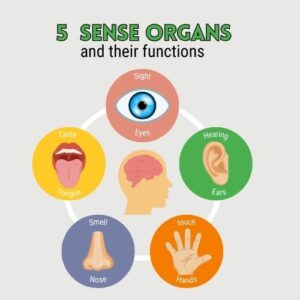
Eyeball: Parts and Functions
• Iris
It is the inner layer that gives color to the eyes. The iris is a pigmented muscle that controls the size of the pupil, which dilates to allow more light to enter the eye or contracts to allow less light to enter the eye.
• Pupil
It is a natural, black, round hole that is in the middle of the iris. It is like a “window” through which the light enters that allows us to see. It behaves like a diaphragm mechanism, regulating the intensity of the light that enters: with the sun it shrinks due to the excess of light and in the dark it dilates. The iris and pupil are covered by the cornea.
• Retina
The retina contains photoreceptors that detect light. It works like a screen, on which images, colors, shapes and the size of objects are projected after passing through the vitreous humour. The retina receives and processes the images that will be transmitted to the brain through the optic nerve.
Human Eye – Structure and Functioning
• Optic Nerve
It is responsible for carrying images from the retina to the brain.
• Sclera
Outer layer of the eye. It is the firm membrane of tough, white fibrous tissue that preserves the inside of the eye and gives it rigidity.
• Cornea
It is located in the anterior part of the sclera and is a transparent layer that allows light rays to pass through. Images enter the eye through this transparent outer window that we call the cornea. Due to its curvature, it functions as a converging lens. It has two functions: one optical and the other to protect the front part of the eye.
• Lens
Behind the pupil and iris is a transparent, biconvex lens called the lens. Function: The lens is used to accommodate the eye and can focus the image of objects that are at different distances. It has small muscles that allow it to accommodate far or near vision. This lens is flattened to see farther, and rounded for near vision. The process of changing the shape of the lens is called accommodation. People lose their ability to adapt as they age, resulting in the need to wear glasses. The main ailment that affects the lens is cataracts.
• Vitreous Humor
Behind the lens, is the vitreous body, which is filled with a colourless gelatinous material, called vitreous humor. This substance shapes the eyeball and also transmits light to the back of the eyeball, where the retina is located. Function: Maintain the shape of the eyeball and achieve a smooth retinal surface, so that sharp images can be received.
• Aqueous Humor
It is a fluid and transparent liquid, formed largely by water. It is located between the lens and the cornea, in the front of the eye. It keeps the eyeball inflated and oxygenates and nourishes the lens and cornea, since both have no blood supply.
Read also: Reproductive System for teens
Taste
The sense of taste allows us to perceive flavors. It is located in the taste buds of the tongue. The receptors on the tongue detect substances, convert them into nerve impulses, and the brain interprets them as flavors. The senses of smell and taste work closely together.
Difference between Taste and Flavor
• Flavor
It is the impression caused by a food and is determined by sensations of smell, taste, texture, temperature, detected by the senses of taste and smell. Taste integrates all the sensory information received in the mouth.
• Taste
Gives us information about the identity of the elements, their concentration and the perception of liking or disliking. The sense of taste is one that allows us to savor food and distinguish which ones we like and which ones we don’t.
The cold, which inflames our nose, prevents us from distinguishing flavors. If you can’t smell something, you don’t want to taste it either.
The papillae of the tongue contain chemoreceptors that detect four types of tastes: sweet, sour, bitter and salty. Food contains chemical substances, when chewing they dissolve in the mouth with saliva. The taste buds on your tongue can detect which chemicals you’re ingesting.

What are the Parts of the Taste?
Sweet
There are several types of receptor papillae. The sweet taste is captured on the tip of the tongue. The sweet taste is produced by a large number of compounds, mainly sugars (fructose, sucrose, lactose). It is captured by the fungiform papillae. Sweets, honey, desserts.
Salty
It is detected on both sides of the front of the tongue. The foliate papillae are responsible for capturing saltiness: salt, fish, ham.
Sour
It is perceived on both sides of the tongue, but a little further back than the previous one. Citrus fruits, lemon juice, vinegar.
Bitter
It is located at the back of the tongue. For example, the taste of coffee without sugar, beer, or grapefruit. Potatoes can be bitter when they are greenish in color. In this case they can be toxic due to their solanine content. The calciform papillae are the receptors for the bitter and acid taste.
The fifth taste: Umami
Umami is the taste produced by glutamic acid, and could be considered a fifth taste. Umami is not tasty, but it enhances the pleasant taste of a large number of foods. All the taste buds on the tongue can detect the umami taste regardless of their location.
Smell
Smell is the sense responsible for perceiving and processing odors through the volatile chemical substances that come through the air we breathe. Odors penetrate through their receptor organ, which is the nose, specifically through the nostrils. These substances act as stimuli to which the nervous system will respond. The nose is also the external organ of the respiratory system. It communicates inside with the mouth, larynx and pharynx.
Nose: Description and Functions
• It is the way we breathe.
• Humidifies and warms the air that reaches the lungs.
• Cleans and filters the air of impurities and contaminants preventing them from entering the lungs.
• Contains olfactory receptors.
In the nose there are specialized cells called Schultze’s olfactory cells that are stimulated by different odors and communicate with the brain’s olfactory bulb through nerve endings. They detect substances present in the air and transmit them to the olfactory bulb as impulses. Our brain is the one that has the ability to distinguish and remember up to 50,000 different smells. Smell and taste are closely related and even connected. Some odors can cause a flavor that is enhanced or different from what is normally attributed to it.
The Olfactory System and our Sense of Smell
What are the parts of the Nose?
• External nose.
• Internal nasal cavity.
Parts of the Human Nose and their Functions
• Nostrils
They are two openings or cavities that are above the mouth whose function is to capture the air and olfactory sensory stimuli.
• Nasal cavity
It is made up of skull bones: the ethmoid and the sphenoid. It is given the name of roof, below is the palate.
• Nasal septum
Divides the nose into two compartments right and left nostril
• Turbinates
They are spongy bone structures that form the walls of the nostrils and are covered with mucosa. They are subdivided into three: superior, middle and inferior turbinate.
• Olfactory Bulb
It is located at the back of the nasal cavities. There is an olfactory bulb for each cerebral hemisphere, and they are considered a part of the cortex. Participates in the transmission of olfactory information from the nose to the brain.
• Pituitary Membrane
Inside the nostrils there is a mucosa called the Pituitary Membrane, it is where the olfactory receptor cells of smell are located, which send information to the brain through the olfactory nerve. It ensures that the air that penetrates into the body is clean. It also heats all the air that is breathed, in cold areas and in times of very low temperatures to avoid respiratory conditions. It has a yellowish tone and is found in the superior turbinate.
• Olfactory Nerve
It is located inside the cranial cavity, where each nerve, when widened, creates an olfactory bulb. Its function is to transmit impulses from the nose to the brain.
How to teach the five senses to kids
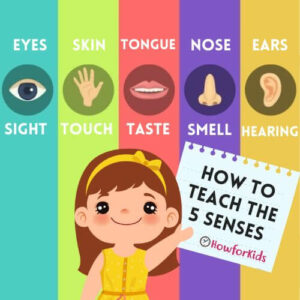
Ear
Double function:
• Hearing organ.
• Maintain the balance of the human body.
To maintain balance, the ear must detect movement. To hear, the ear detects sounds, their volume, pitch, timbre, and the direction they come from.
In the ear there are receptors that respond to vibrations that the brain interprets as sounds. Although it is only able to hear a range of sound waves. It does not perceive vibrations less than 20 times per second, nor greater than 20,000 times per second.
Parts of the Ear and their Functions for primary school
Outer Ear
Function: Receive sounds and conduct them to the middle ear.
• Pinnae, which we commonly call ears. They are the outer part of the ear, where sounds that are transmitted through the air are received.
• External auditive conduct. It is a tunnel lined with sebaceous glands, secreting wax that protect the eardrum.
• Eardrum is a membrane that vibrates with sounds. It divides the outer ear and the inner ear. And when it vibrates it moves the “bones” of the middle ear.
Middle Ear
The middle ear is the part of the ear that is between the eardrum and the oval window.
Function: Transmit sounds from the outer ear to the inner ear.
It is made up of three tiny bones: the hammer, the incus, and the stirrup, the oval window, the round window, and the Eustachian tube.
The oval window is a membrane that lines the entrance to the cochlea in the inner ear.
The Eustachian tube connects the ear with the palate. The function is to equalize the pressure of the atmosphere on both sides of the eardrum, and to ensure that this pressure does not increase inside the ear. In most cases, the pressure equalizes automatically, but sometimes it is necessary to swallow forcefully, which will force what connects the palate to the ear to open, balancing the pressure.
Inner Ear
The inner ear is made up of tubes and ducts, known as the labyrinth where the vestibule and cochlea are located.
Function: Transform vibrations into nerve impulses
• The cochlea. It is shaped like a snail or “coiled hose” and is responsible for hearing. It connects with the auditory nerve through the semicircular canals.
• The semicircular canals. They do not intervene in the perception of sound, but are responsible for maintaining the balance of the body.
• The lobby. It is the organ of balance, it is formed by the saccule and the utricle. The function of the vestibule is to register the movements of the body to maintain balance.
How does the ear affect balance?
It has three ring-shaped tubes that are filled with fluid that moves according to the movements of the body itself. The ducts are oriented in three different planes. These ducts also contain thousands of hair fibers that react to fluid movement, sending tiny impulses to the brain. The cilia transmit impulses to the brain about body movement in all directions, angles, and rotations, as well as movement through vertical and horizontal planes, helping you maintain balance.
The brain decodes them and uses them to maintain the balance of the body. The fluid within the semicircular canals of the inner ear moves, and that movement is ultimately detected by the cilia. When the fluid does not stop moving you can develop dizziness.
• Auditory Nerve: The auditory nerve has the function of transmitting signals from the inner ear to the brain.
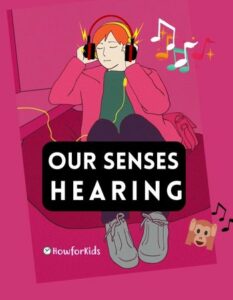
How the Ear Works
When the vibrations reach the external ear through the air, they are transmitted through the ear canal to the middle ear. There, the sound waves meet the membrane that is the vibrating eardrum. This vibration is transmitted to the bones of the middle ear and reaches the cochlea which contains a fluid that is agitated. The cochlea contains hair cells (they have a kind of “little hairs”) that connect to the auditory nerve. When they move, they send electrical signals to the hearing nerve that is connected to the brain. The electrical impulses are translated in the brain as sounds that we can recognize and understand. These hair cells are essential for our hearing. If these hairs are damaged, the hearing capacity deteriorates.
Touch
How the Sense of Touch Works
Organ of Touch: The Skin
The skin is the largest organ because it covers the entire length of your body. It has different types of receptors to perceive: temperature, pressure, pain and contact.
Sense of Touch: Functions
Through touch we can recognize if an object is hard, soft, smooth, rough, if it is hot or cold, if it is wet or dry, and others.
Throughout your skin, all four classes of receptors are interspersed. When the skin receptors are activated, they generate impulses that go to the spinal cord and the brain so that it decodes them and sends the appropriate response.
However, the skin is not the only tissue in the body that has receptors. The organs also have receptors. Joints, ligaments, and tendons contain proprioceptors, which detect the position and movement of the limbs. The sense of touch is called mechanoreception.
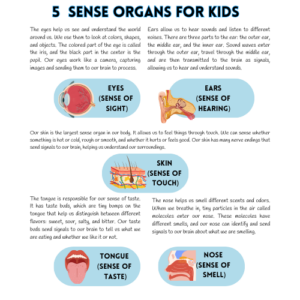
Fun Facts of the Senses for Kids
• The tongue can have from 2.000 to 8.000 taste buds.
• Most of our hearing is in the head. It is not the part that we can see. The part of our ear that we can see helps pick up sound waves in our middle and inner ear.
• Our ears have about 24,000 sensory cells.
• The smallest bone in our body is in our ears, it is called the stapes.
• A person’s eyes can distinguish approximately 10 million different colors.
• The iris and retina inside your eye don’t look like anyone else’s, just like your fingerprints.
• The skin is the largest organ we have, because it covers our entire body.
• People who cannot see are known as blind. They can learn to read books by touching their pages. Words are made up of little bumps on the page: this is called the Braille System.
• Those who cannot hear are known as deaf. Sign language is a way of speaking using the hands, and in this way deaf people can understand what others are saying.
• We need our sense of smell for our sense of taste to work properly: if you hold your nose shut while you eat, the taste won’t be as strong. That is why you do not taste food when we have a cold and our nose is “stuffed”.